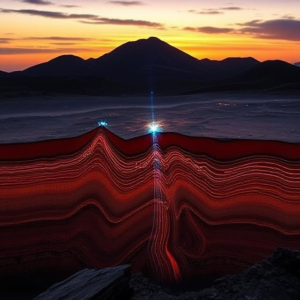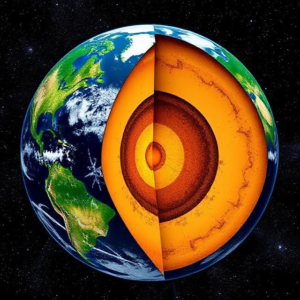Geophysics is the study of the physical properties of the Earth, like its structure, the forces that shape it, and how energy flows within it. Geophysicists use this knowledge to understand the Earth’s inner workings, predict natural events, and explore for natural resources.

1. Seismology and Earthquake Waves
Seismology is the study of earthquakes and the waves that travel through the Earth when an earthquake occurs. When the Earth’s crust breaks or shifts (like during an earthquake), it sends shock waves through the ground. These waves are called seismic waves.
There are three main types of seismic waves:
- P-waves (Primary waves): These are the fastest waves and can travel through both solid and liquid. They move the ground in a push-pull motion, like a slinky stretching and compressing.
- S-waves (Secondary waves): These are slower than P-waves and only travel through solids. They move the ground in a side-to-side motion, like a snake wriggling.
- Surface waves: These are the slowest seismic waves, but they cause the most damage during earthquakes. They travel along the Earth’s surface, causing buildings and structures to shake in circular or rolling motions.
When an earthquake happens, seismographs (special instruments) measure these seismic waves, and by studying their speed and path, we can learn about the Earth’s inner layers.
2. Earth’s Magnetic Field
The Earth’s magnetic field is like a giant magnet surrounding the Earth. It’s generated by the movement of molten iron and other metals in the Earth’s outer core.
Why is it important?
- The magnetic field acts like a protective shield, protecting the Earth from harmful solar radiation and charged particles from the Sun (called the solar wind).
- The magnetic field is responsible for the compass—it makes a compass needle point to the magnetic north.
The magnetic field is not fixed—it fluctuates over time and can even reverse, meaning the magnetic poles swap places. This has happened many times throughout Earth’s history, and scientists study these reversals to understand more about the Earth’s interior.
3. Plate Tectonics and Geothermal Heat
Plate tectonics is the theory that the Earth’s outer shell, called the lithosphere, is divided into large pieces called tectonic plates. These plates are like giant puzzle pieces that float on top of the mantle, a layer of hot, semi-liquid rock below the crust.
How do the plates move?
- Convection currents in the mantle (caused by heat from the Earth’s core) push the plates around. This movement happens very slowly, at a rate of a few centimeters per year.
Types of Plate Boundaries:
- Divergent boundaries: Plates move apart. This happens at mid-ocean ridges, where new ocean crust is created.
- Convergent boundaries: Plates move toward each other. One plate may be forced under the other in a process called subduction, which can lead to volcanoes or mountain ranges.
- Transform boundaries: Plates slide past each other. This causes earthquakes, like the ones along the San Andreas Fault in California.
Geothermal Heat:
The heat inside the Earth comes from two main sources:
- Residual heat from the Earth’s formation (how the Earth was originally formed and heated up).
- Radioactive decay of elements like uranium and thorium in the Earth’s interior.
This heat is responsible for processes like volcanic activity and hot springs. In some areas, the geothermal heat can be harnessed to produce geothermal energy, which is used to generate electricity or heat buildings.
Where can we see it?
- Volcanoes are an example of geothermal heat at work. When tectonic plates move, magma from deep within the Earth can escape to the surface and cause volcanic eruptions.
- Hot Springs are another example, where water from deep inside the Earth comes to the surface, heated by the geothermal heat below.
Summary:
- Seismology and Earthquake Waves: Seismology helps us understand earthquakes by studying seismic waves, which travel through the Earth when it shakes. P-waves and S-waves are the most important types of seismic waves.
- Earth’s Magnetic Field: The Earth has a magnetic field that protects us from solar radiation and helps with navigation using compasses.
- Plate Tectonics and Geothermal Heat: The Earth’s outer shell is made of moving tectonic plates, which cause earthquakes, volcanoes, and mountain ranges. Geothermal heat from the Earth’s interior powers volcanic activity and can be used for energy.
Geophysics helps us understand the powerful natural forces that shape our planet and how we can use this knowledge for things like energy, safety, and exploration.











